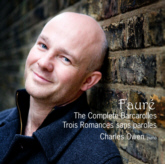Fauré favored the barcarolle or gondolier-song genre, perhaps constantly competing with Chopin's one contribution, Op. 60. Faure's thirteen Barcarolles - originating within a period of almost thirty years - 1881-1921 - appear through his work as a constant refrain, and their variety is fascinating: here the gloomy monotony of No. 9; there the very special, rhythmically harmonious refinement in No. 5; the magical hovering between major and minor in No. 3; or the playful nonchalance of No. 8. Faure occasionally used the titles "Nocturne" and "Barcarolle" interchangeably, the pieces' exploiting the alternative flexibility in both hands, given Faure's own ambidextrous powers.
British pianist Charles Owen recorded the set of Barcarolles on a Steinway D, 5-7 July 2010 at the Wyastone Concert Hall, Monmouth. After the relatively simple A Minor harmony and cross-rhythms of the Op. 26 (1881), the No. 2 in G Major, Op. 41 (1885) takes its ambiguous harmonic cues from Liszt and Wagner. Already the modal element in Faure's delicious music exerts itself. Barcarolle No. 3 in G-flat Major, Op. 42 (1885) begins as a simple parlando but its improvisatory evolution proves highly chromatic, the liquid impulses lapping and vibrating in Lisztian water droplets and sprays we know from the Villa d'Este. Its "false" ending leads to an extended epilogue of haunted beauty. Faure dedicated the relatively condensed Barcarolle No. 4 in A-flat Major, Op. 44 (1886) to composer's Ernest Chausson's wife. Its opening reminds us of Chopin's Andante spianato, but its rhythm canters in spilled harmonies that employ descending chords for the central section.
Faure's expanded notion of harmony manifests itself in the F-sharp Minor Barcarolle No. 5, Op. 66 (1894), the result of his having visited Venice and engaged in a liberating affair with socialite-singer Emma Bardac, later the wife of Claude Debussy. Owen negotiates its bluesy flourishes with panache and liquid facility. Barcarolle No. 6 in E-flat Major, Op. 70 (1896) conveys a salon style likely earlier than its purported published date. Marked "Allegretto vivo," the music moves in rushes and retreats of arpeggios, always smeared in harmonies reaching elsewhere in space. The 1905 Barcarolle No. 7 in F-sharp Minor represents a leaner style that had infiltrated Faure's modal harmony in the ten years since his last such entry. Layered and dreamy at once, the music might have been stolen from that island of Cythera that inspires Debussy's L'isle joyeuse. The most genially playful of the set, the Barcarolle No. 8 in D-flat, Op. 96, mimics Debussy's whole-tone progressions and syncopated octaves. Owen's Steinway reveals its capacity to intone soft tissue and gliding bass harmonies, with nice sonic balance, courtesy of engineer Simon Eadon.
A new sound world opens the 1909 A Minor Barcarolle, Op. 101, with its intimations of plainchant fused to rocking rhythms. The minor third interval proves obsessive and triumphant in this piece, which gravitates somewhere between Chopin, Debussy, and Rachmaninov. Faure conceived Barcarolles Nos. 10 in A Minor and 11 in G Minor as a diptych, a kind of memorial for Noemi Lalo, the late wife of a music critic. The latter of the two barcarolles proves the more exotic, exploiting modal harmony in disturbed askew patterns. Faure's "harmonic staircase" effect involves layered descending harmonies that land on pearly arpeggios. The G Minor, composed in Lugano, borrows from the sensibility of his opera Penelope, the ultimate symbol of wifely devotion. Saint-Saens found the Barcarolle No. 12 in E-flat Major, Op. 106 (1915) to his relatively conservative taste. Over a liquid bass, the treble melody sings and expands, then engages in dialogue with ever-shimmering figures. Faure scholars place this piece earlier than its stated opus number declares. The last of the set in C Major, Op. 116 (1921) achieves a luminous simplicity, the result of years of creative synthesis.
Owen ends his program with three pieces from Faure's 1860s excursions into exercises commanded by his teacher Saint-Saens, whose love of Mendelssohn's keyboard works was no secret. Two A-flat Major studies surround an exercise in A Minor. Graceful, lyrical, eminently tasteful, they serve as a commentary on the entire album as well done.
* * * * (Four stars)
 Back to List
Back to List